PG. 1 OMEGA
PG. 7 TISSOT
PG. 9 YURMAN
PG. 11 NOMOS
PG. 13 ROLEX
PG. 17 HAMILTON
PG. 19 LÜM-TEC

PG. 1 OMEGA
PG. 7 TISSOT
PG. 9 YURMAN
PG. 11 NOMOS
PG. 13 ROLEX
PG. 17 HAMILTON
PG. 19 LÜM-TEC

Watchmaking may not be rocket science, but there’s one watch company rocket scientists trusted when they wanted to put a man on the moon: Omega.
Since then, Omega’s reputation has only continued its upward trajectory.
NASA put out a call to watchmakers around the globe when they were trying to find a watch the astronauts the Apollo 11 crew would wear. Only four accepted the challenge: Omega, Rolex, Hamilton, and Longines-Wittnauer. Hamilton was eliminated immediately for submitting a pocket watch instead of a wristwatch, leaving three finalists.
They had to survive a gauntlet of 10 tests in different extreme conditions without a single failure to see how they would respond to the conditions on the moon’s surface – where the weak atmosphere allows for drastic shifts in temperature from 250 degrees to negative 200 degrees – as well as the conditions it could be exposed to on the journey there. Rolex submitted the “pre-Daytona,” LonginesWittnauer submitted the 235T, and Omega submitted the Speedmaster 105.003.
They were subjected to temperatures comparable to that of the moon, along with rapid fluctuations in temperature and pressure. They went through a shock test, acceleration test, and more.
Rolex failed three times. It stopped running twice during the humidity test and failed one of the temperature tests. LonginesWittnauer failed two, the temperature test and the decompression test. The Speedmaster wasn’t perfect – it gained 21 minutes after the decompression test and lost 15 minutes after the acceleration test – but the winner was clear.
NASA saw the performance of the Speedmaster in more detail than any watch customer could conceivably in a store and made their choice: Omega was up to the task of creating a timepiece that was so robust, so pure in its design, that it would be able to function in an




environment never conceived of by the old masters of watchmaking.
The Speedmaster’s first trip to outer space was in 1965 aboard the Gemini 3, the first crewed mission of NASA’s Project Gemini, which would test spaceflight techniques in preparation for the Apollo missions and allowed the United States to close the gap with the Soviet Union’s space program.
The watch was worn by Edward White as he made the first spacewalk, which was the first time a human had been in space without the protection of a vehicle, earning it the nickname the “Ed White.” The next step was a giant leap for mankind, and a rocket launch propelling Omega into the history books.
All three members of the Apollo 11 crew
unchanged, at least on the outside. The watch was worn on all six of NASA’s moon landings – the last of which, sadly, was in 1972 – and Omega has continually updated its movement and other aspects to meet the agency’s evolving standards for their astronauts’ wrist-wear in the decades since.
But the foundation of Omega’s reputation is the Calibre 321 movement, the beating heart of the watches that made it to the moon. In honor of the 50th anniversary in 2019, Omega released an updated version of the iconic timepiece, Speedmaster Moonwatch 321 Platinum, which even incorporates a piece of the moon in the design: three subdials each are made from genuine lunar meteorite.
standards and their own, but Omega chose to follow the guidance of an impartial third-party in METAS instead.
METAS conducts eight tests on watches before granting this certification, including whether it’s as water resistant as a company claims and if it’s reserve power lasts as long as advertised. METAS requires a minimum daily accuracy of 0/+5 seconds per day and the ability to withstand a 15,000 gauss magnetic field –your average refrigerator magnet is about 50 gauss.
Of the different specifications of the Speedmaster available, only those with a hesalite crystal are considered flight qualified by NASA. Sapphire crystals would shatter into small pieces, making
Watchmakingmaynotberocketscience,butthere’sonewatchcompanyrocket scientiststrustedwhentheywantedtoputamanonthemoon:OMEGA
were wearing different models of Omega Speedmasters for their mission, though it was Buzz Aldrin who wore it (reference 105.012) on the moon’s surface. The “moonwatch” was born.
When Aldrin’s foot touched that strange new terrain, it sent a message to the world that when it comes to performance watchmaking, Omega is light-years ahead of the competition. As human ambition climbs to new heights, so too goes Omega.
The year after the moon landing, Omega’s prowess saved the lives of the astronauts aboard Apollo 13. An oxygen tank ruptured two days into their trip to the moon, causing the craft’s electrical and life-support systems to fail. The steadfast Speedmaster allowed the three-man crew to properly time engine burns as they made their way back to Earth, averting disaster. Since then, the Speedmaster went largely
The new Calibre 321 keeps many of the signatures of the original, down to the ceramic bezel and the dot over 90. For those who like to see behind the curtain, the updated Moonwatch has a transparent caseback showing every detail of the elegant machinery that guided some of the bravest of our species on their trek into the unknown.
The latest iteration of the Speedmaster, along with the vast majority of all Omega’s output these days, is being held to a higher standard than ever before for typical, commercial functions. In 2015, Omega began building its watches to its Master Chronometer standard.
To earn the distinction of a Master Chronometer, a watch must meet the standards of the Swiss Official Chronometer Testing Institute (COSC) and of the Swiss Federal Institute of Metrology (METAS). Other watch companies often only certify their watches by COSC’s
the dial unreadable when damaged, while the hesalite – a specific type of acrylic glass originally made by Omega in the 1940s – would only get cracked, dented or scratched.
The Speedmaster Moonwatch
Professional, reference 310.30.42.50.01.001 ($7,000) with the NASA flight-qualification and leather strap, and the reference 310.32.42.50.01.002 (($7,600) with its all-steel loo, will satisfy any buyer with an appreciation of the best craftsmanship.
Wherever man goes beyond our current home, it’s Omega who will be trusted to keep us on Earth’s schedule. |

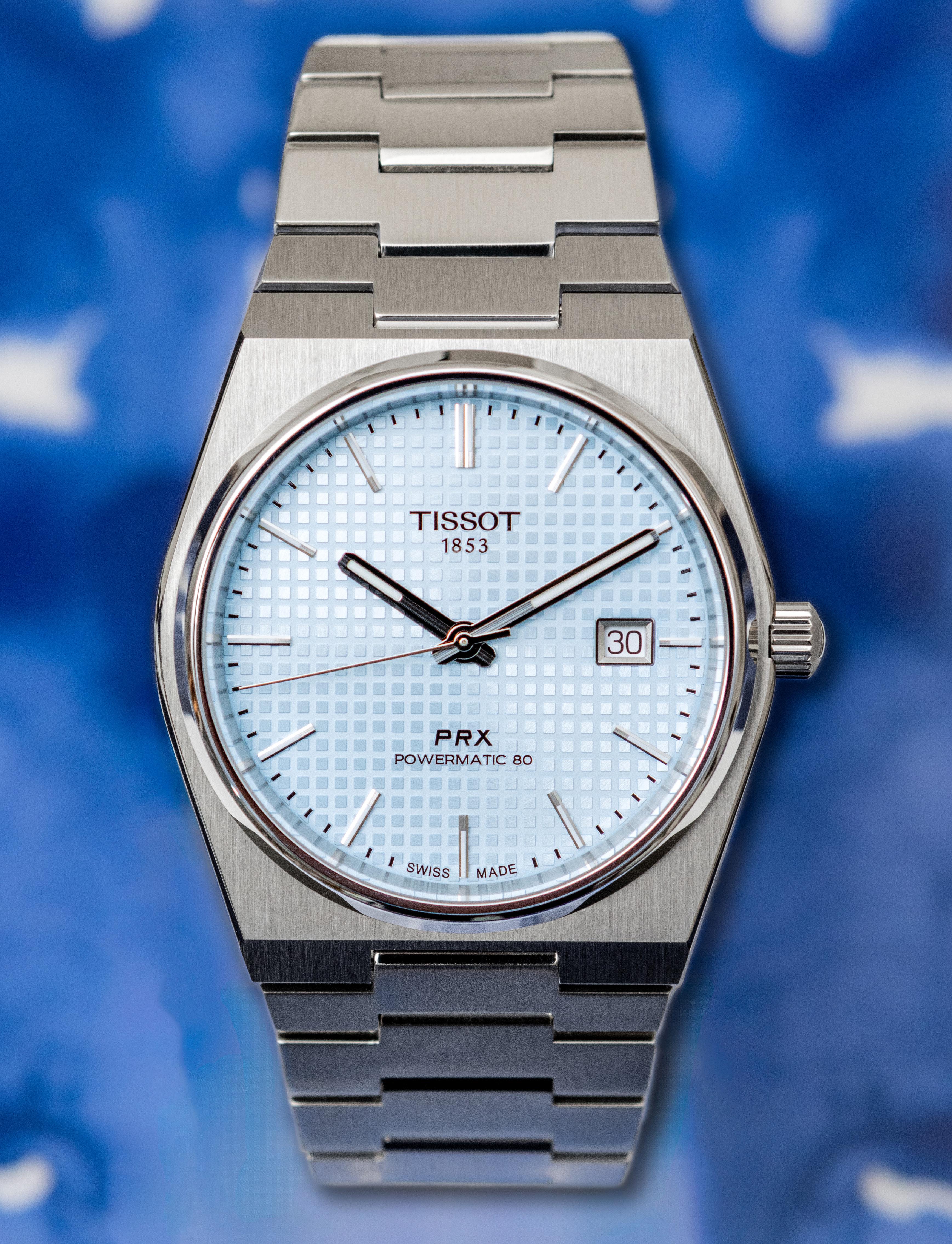
It would be easy for a watch brand that has achieved a certain status over generations to lapse into pointing back to its glory days to keep customers coming back to them, using nostalgia as a crutch. But the first law of watchmaking is that time only ticks forward, and thus time itself demands that a quality timepiece must continue to earn its place in the present if it hopes to make it to any future.
Tissot, a Swiss watchmaker of the highest order, has made this constant push for innovation into a tradition of their own. Since 1853, Tissot has not only been on the cutting-edge of timepiece technology, the company has also invested in keeping the art of watchmaking alive long term.
Charles-Émile Tissot, who co-founded the company with his father CharlesFélicien Tissot, built watchmaking schools in their hometown of Le Locle, Switzerland and acted as an ambassador for Swiss craftsmanship across the world powered by the performance of their pocket watches. They had their first major breakthrough in Russia in the mid-19th Century, dominating the Slavic market and even attracting the eye of Tsar Nicholas II.
Withstanding the onslaught of worldshaking catastrophes including the internal conflicts in Russia in the early 20th Century and the global financial collapse of 1929, Tissot emerged as a powerhouse able to self-produce all the components of its watches. Tissot was the first to create a non-magnetic watch, meaning it wouldn’t be impaired by electricity which had now
become ubiquitous, and was among the first companies to produce wearable wrist watches.
The same brand once fancied by the Tsar of Russia has now been seized upon by Gen Z, who are now at the age to be defining global markets at the whims of their ephemeral tastes. Coming of age in the aftermath of the Great Recession, entering their prime working years during the pandemic and instability in
The price tag tops out at just under $2,000 for those who want to add some extra sparkle on their wrist.
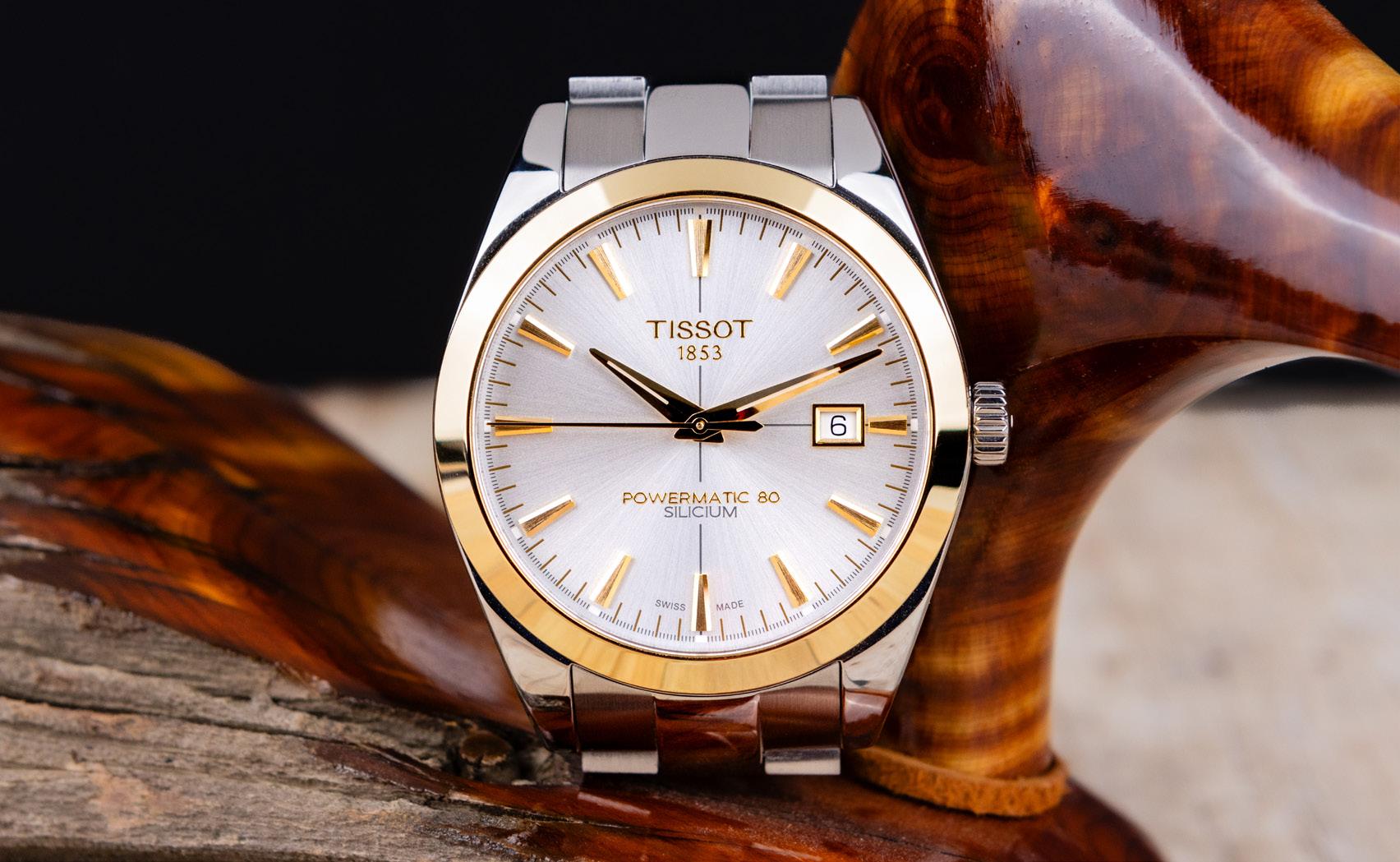
virtually every direction, studies show this generation values frugality and function above any lofty, old-headed appeals to a life of “luxury” that is increasingly out of reach.
The majority of Tissot’s collection of timepieces are in the $375 - $850 range, accessible to the young watch aficionado and an easy choice for casual wearers of any generation looking for the best value.
Tissot offers a wide array of watches, each giving the wearer the gift of time while evoking a sense of stylish elegance without sacrificing function. They come in seven sizes from 28-30 mm up to 44-46 mm, nine dial colors including “Mother of Pearl” and “Champagne,” straps of metal, leather or synthetic material, and automatic and quartz movements.
Tissot knows it’s not the bells and whistles or the glistening jewels that make a watch great, it’s the artful interplay of design and mechanical craftsmanship that honors the deep roots laid in the mountains of Switzerland by the passionate watchmakers of old. |
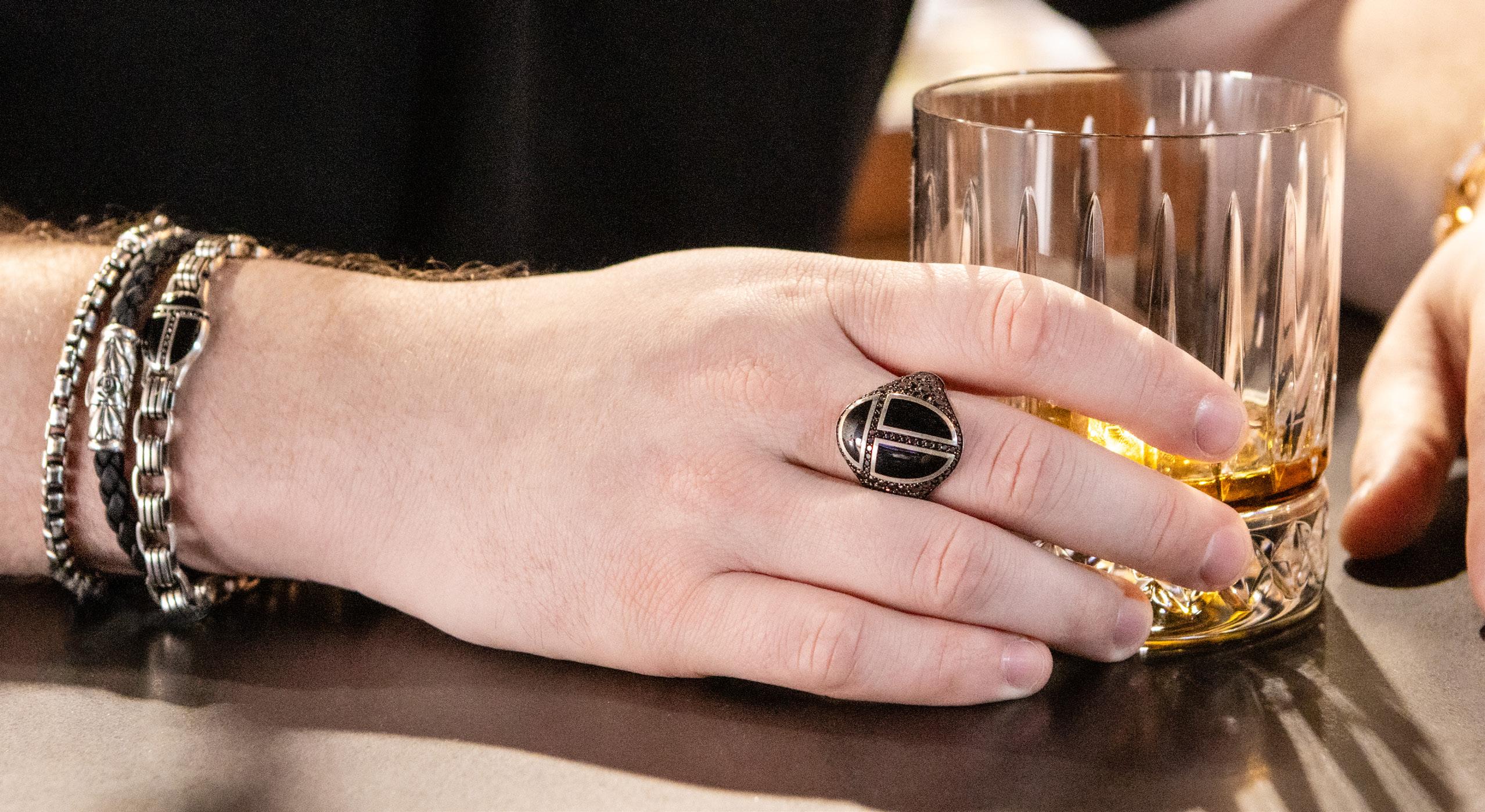


At a time when the lines that once separated men’s and women’s apparel have never been more blurred, tracking with our culture’s wider acceptance of gender expression, David Yurman is establishing its own space outside those lines with a renewed focus on men’s jewelry.
Over the last century, men’s jewelry, and fashion culture broadly, in the U.S. has gone from being virtually nonexistent, rigidly uniform, rugged or minimalist, to gaudy and in-your-face in the early part of the 21st century. In the late 2010s and now 2020s, men have branched out to adopt kitschy, ironic styles – looking “bad” on purpose – and unabashedly donning jewelry, like pearl necklaces and diamond rings, that were once the exclusive purview of women.
This movement hasn’t made men the primary consumers of jewelry by any stretch, but has resulted in making men’s jewelry the fastest growing segment of the market.
While some push to the furthest edges of expression, other men are flourishing in a more stylistically accessible terrain of luxury fashion where they can subtly accent their visage with a measured degree of sophistication. This is where David Yurman has chosen to stake the future of its line of men’s jewelry.
About 15 years after Yurman formally launched its men’s section in 2004, headed by the brand’s heir, Evan Yurman, sales of men’s items made up about 20%
of its total business, seeing growth of nearly 70% in sales in the five years before the pandemic.
Yurman’s offerings for men embody the class and elegance that has defined the brand since its founding in 1980. Their signature cable style is featured heavily in every line, but each incorporates a wide range of designs made with both traditional and exotic materials that expand the idea of a Yurman piece.
first jewelry piece for Sybil to wear to an art gallery – a welded, freeform bronze necklace that looks as if a metal root system grew around her neck – where it caught the refined eye of Jacques Lipshitz, a mentor of David’s under whose tutelage he developed the early forms of the company’s signature cable design. Lipshitz asked if the necklace was for sale, and the rest is history.

Sleek necklaces that hang loose with casual flair. Bracelets that shimmer in the light and others that absorb it. Rings that exude power and excellence, wisdom and fearlessness. Pendants that draw the eye and add weight to a man’s presence in the room. At every price point, from under $200 up to $87,000, a man can find a piece that defines his impact on the world.
For the company’s namesake and his wife, Sybil, creating jewelry has always been about the collaboration with the one they love to create a physical expression of that love. A sculptor by trade, David made his
The lovers made art of their lives together – “dreaming with my hands,” as David put it. He has said his designs were often based on what Sybil would wear. Evan Yurman guided his family’s business through the COVID-19 pandemic that threatened sales across nearly all industries, coming out on the other side with a nearly 150% increase in e-commerce revenue and roughly doubling their 2019 sales.
Thanks to David and Evan Yurman, men’s jewelry has a bright future. |
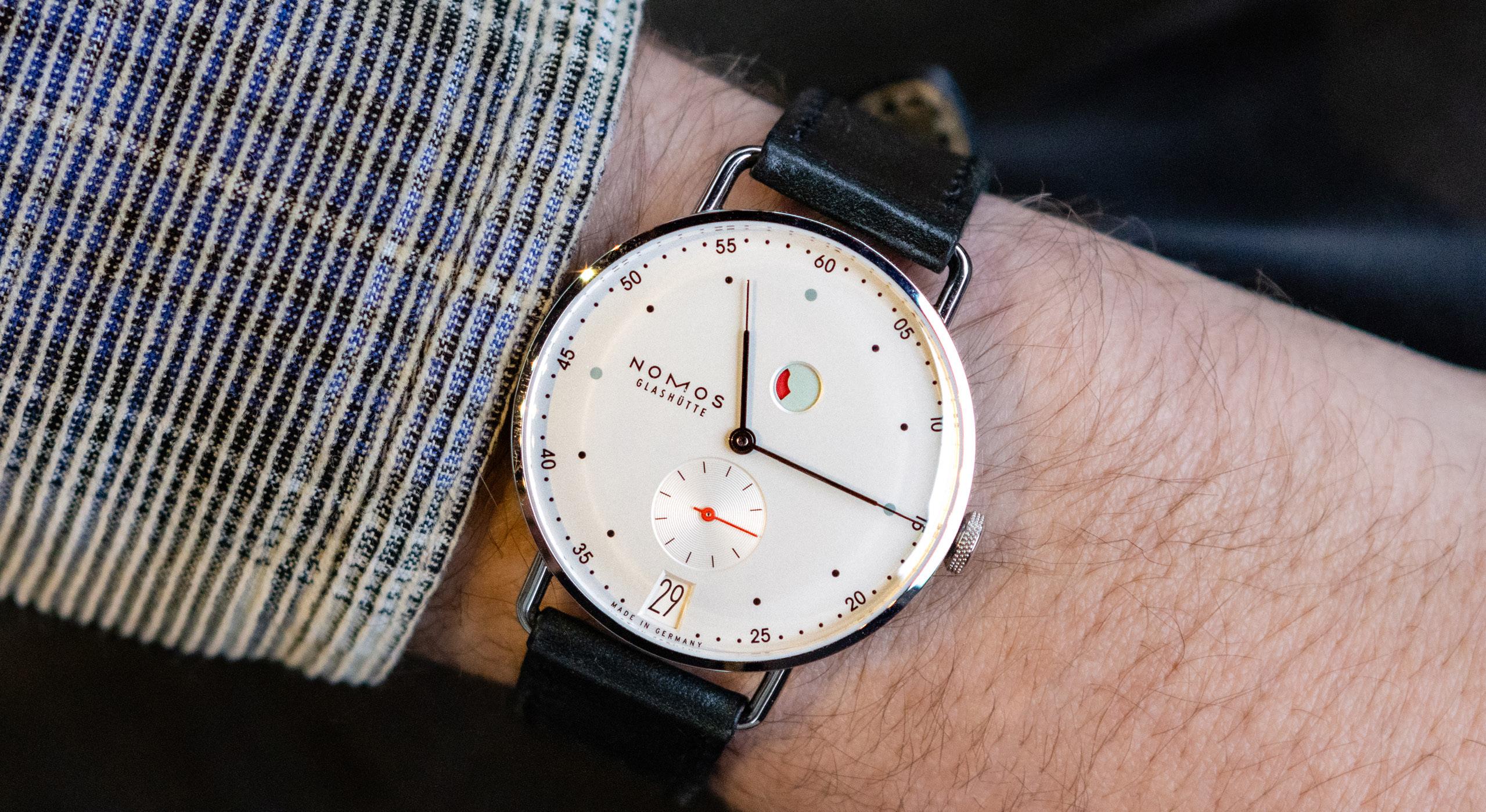
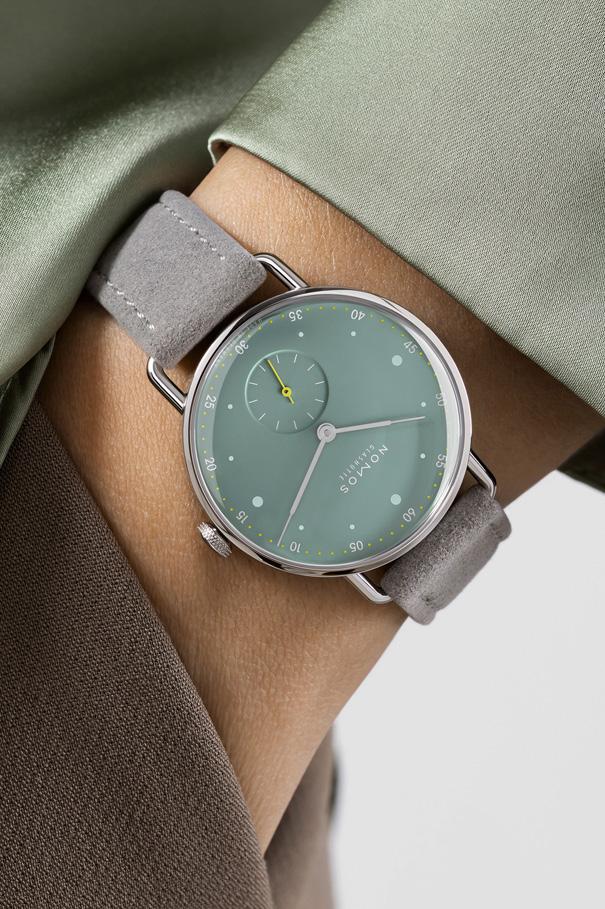

The New York minute – a unit of measure born out of the sensation that your environment is so intense, so viscerally engrossing that minutes as we know them lose all meaning – can be disorienting. You look down at your generic watch, and it can’t keep up.
But there’s one watch whose immaculate visage and precision draws the wearer into the Big Apple’s gravitational pull no matter where they are, bringing them into alignment with the city’s unyielding timeline.
The Metro Collection by NOMOS Glashütte, which debuted in 2014, is inspired by that iconic concrete jungle forever synonymous with human progress. The Metro’s latest designs, the Metro 33 – so named for their 33mm diameter – evoke the synesthetic impressions New York leaves on anyone
the value of a watch’s caliber in Glashütte are allowed to label their timepieces as “Glashütte watches”. This benchmark has been an unwritten rule for those seeking to claim Glashütte’s prestige, but as of 2022, watchmakers are legally required to follow it – same as with the label of “Swiss Made” –largely thanks to the advocacy of NOMOS.
NOMOS both helped set that standard and exceeds it: up to 95% of each of its calibers are made in Glashütte. The company also sets itself apart in that it makes its own escapement, known as the NOMOS swing system.
All this hard work and attention to detail has paid off. True watch aficionados are chomping at the bit to get their hands on a NOMOS, to the point where it’s harder to keep up with demand than it is to sell them.
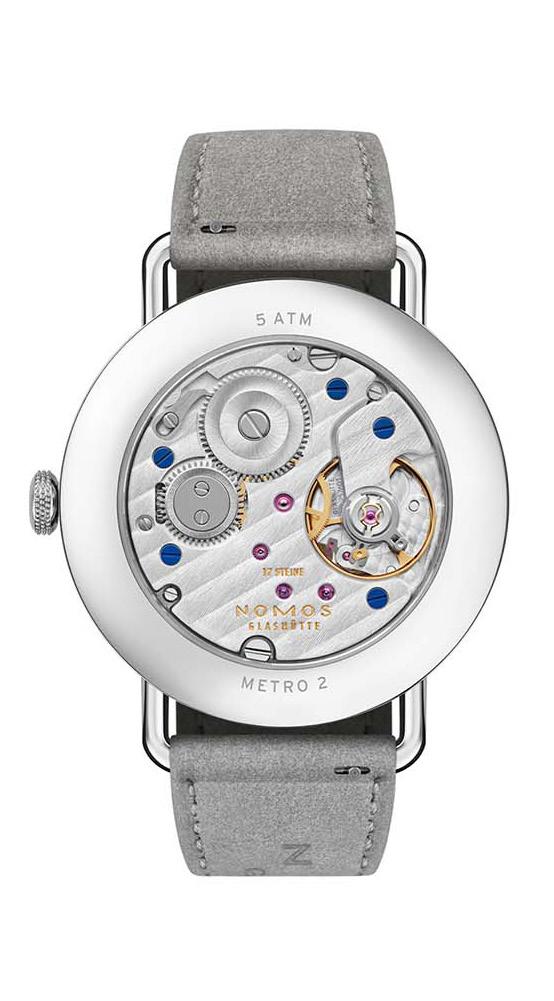
TheMetrocollectionincludes14watchstyles,eachwithadistinctpersonality alltheirown,inmanualorautomaticandinvaryingmillimeters.
who spends time there with the unique colors of their dials: the metallic sheen of the skyscrapers, the cozy clutter of its brick apartments and row houses, and the lush green spaces that fill in the gaps.
If you look closely, the Metro’s hands are drawn in a subtle silhouette of the Empire State Building. All together, these elements produce a sleek, minimalist accessory for one who freely makes waves in an otherwise dense setting that can seem impenetrable to the uninitiated.
Glashütte, the luxury watchmaking capital of Germany and a jewel of a town tucked away in the Ore Mountains. Only companies that create at least 50% of
The Metro collection includes 14 watch styles, each with a distinct personality all their own. They offer manual and automatic and come with diameters of 33mm, 35mm, 37mm, 38.5mm, and 40.5mm. Their slender cases range in thickness from 7-9mm, and come in stainless steel and rose gold, with straps of leather, vegan velvet, and woven.
The dials come in playfully colorful styles –mint green and red details – and others with a distinguished, elegant visage. In addition to the city-inspired colors named above, the dials are midnight blue, rhodium plated, galvanized white silver-plated and urban gray.
This luxury collection falls between $2,030 and $10,920, a price point that sets it above the range for casual collectors and those new to fine watches, targeting instead those with a refined taste for form, function, precision and style.
Catch up to New York time with a NOMOS Metro today. |

When you’re down in the depths of the deep blue sea, with nothing but a wetsuit between you and the jaws of nature, cardinal directions blurring with up and down, there’s one watch you can trust to be your guiding light.
The Rolex Submariner set the high water mark for diving watches when recreational diving took off after World War II and has maintained that status in the decades since. First released in 1953 with reference 6204, the Submariner was the first watch able to guarantee water resistance at a depth of 100 meters.
Rolex got in early making watches waterproof which led to its coining of the Oyster case in 1926 – its first step away from luxury jewelry and towards an everyday accessory – and followed that up with the creation of its self-winding perpetual movement. Other watch companies were forced to sync their timepieces to “Rolex Standard Time.”
Due to its rotating timing bezel, luminous hands and comfortable bracelet, the Submariner popularized the concept of a “tool watch” in the market, creating an expectation that watches can serve a greater purpose than simply telling time – much like the iPhone shifted the
expectation of phones beyond simply making calls.
To those that don’t know their history, the Submariner may seem unremarkable, like a basic wristwatch. If it looks common it’s partly because it is – the watch is virtually ubiquitous – but also because it inspired so many other watch designs at a time when the market was exploding with competitors and innovation. Rolex has had little cause to change its look since. Why change if you get it right the first time?
Its longevity at the top is the result of putting function over form.
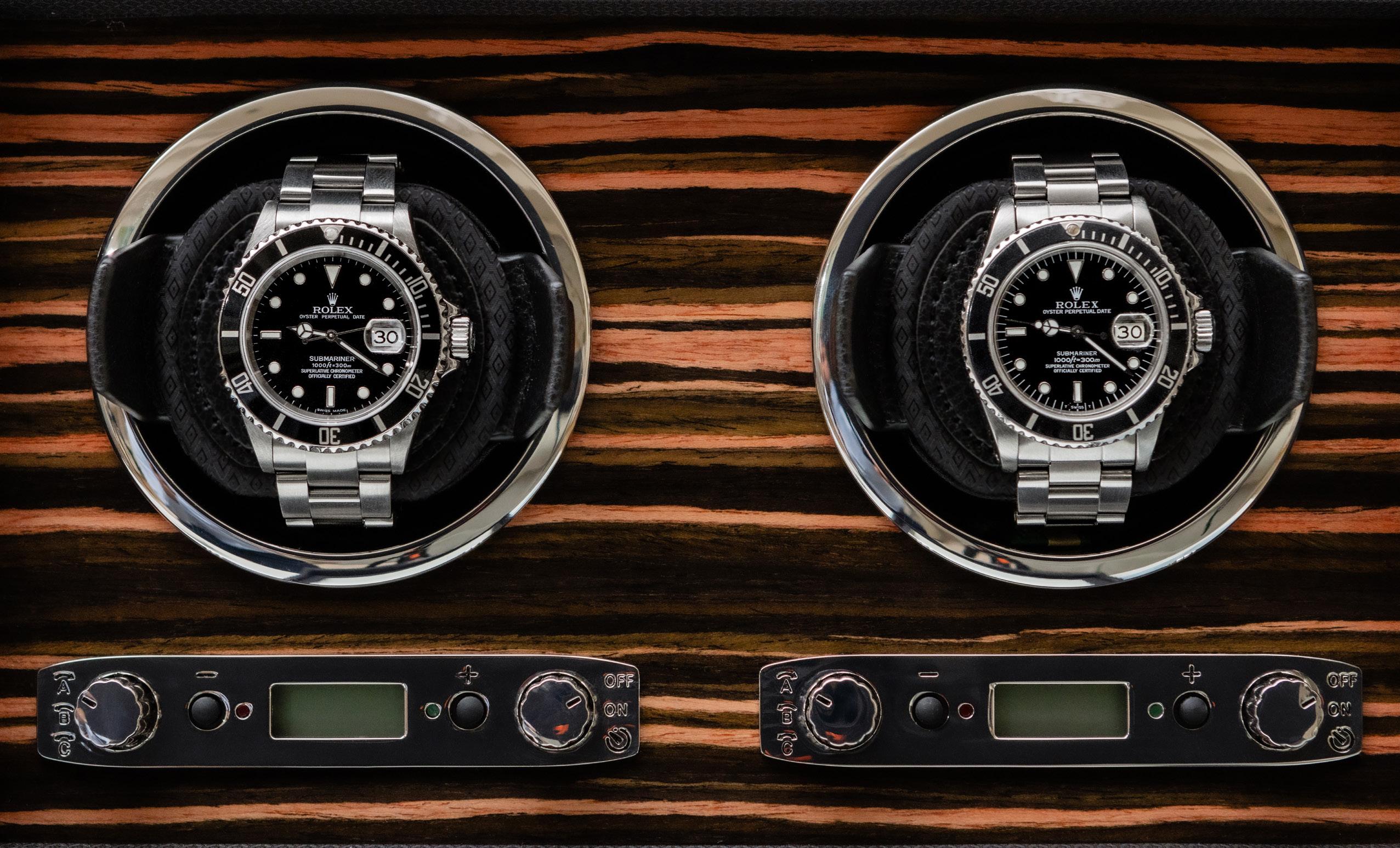
In case you’re not convinced, in summer 2023, an Australian surfer and diver was snorkeling off the coast of Queensland when he noticed something stuck under a rock. Upon further inspection it turned out to be a Submariner, worn down and crusted over with ocean debris. To his amazement, it was still ticking, and the inscription on the back was still visible. After the story caught traction online, he was able to find the original owner, Ric, who said he’d lost it five years prior after wearing it for 48 years.
were largely confined to the materials, movements, and minor design variations until 2008 when Rolex introduced the Submariner with a larger Maxi case.
In 1967 came another watershed moment for the Submariner. Initially intended as a pure tool watch, with its acrylic crystal, stainless steel case and simplistic dial, Rolex released the reference 1680, which was the first reference to have a date window and it introduced precious metals into the collection. Fans of the Submariner
distinction from its predecessor was that it featured 904L stainless steel instead of the widely used 316L – but its rarity gives it a character that adds great depth to the Rolex lineup.
Rolex was there when diving exploded into popular culture, plugged in with the premier experts in the sport. Jacques Cousteau himself, the famed diver and inventor of the Aqua-Lung – the first scuba tank that released air on command allowing divers to spend more time underwater – whose
Rolexwastherewhendivingexplodedintopopularculture,pluggedinwiththe premierexpertsinthesport,likeJacquesCousteau.Fortyyearslaterthetimepiece acheivedOscarfamewithJamesCameronandTitanic.
The watch had been gifted to Ric when he was 18 by his father, who won it in a local sailing race. Because of Rolex’s immaculate craftsmanship, that memory was preserved.
That watch was a reference 5513, one of the most iconic models of the Submariner, which ran from 1962 to 1989. It was the successor to the 5512, which ran from 1959 to 1980. The 5512 represented Rolex hitting its stride after pumping out a quick series of references over the previous years. With the 5513 being so similar – the primary difference being that the 5513’s movement isn’t a COSC-certified chronometer – it only served as further proof of the company’s confidence in their product and of the consumers’ preference.
Because of their staying power, the 5512 and 5513 were elevated to something beyond a watch. They became symbols of a time and place in watchmaking itself, and defined an era that nostalgic collectors want to own a piece of. These references also became the foundation for virtually every other present-day Submariner as it evolved, but its soul remained consistent. The updates in the years that followed
for its rugged utility saw this as a step towards it becoming a status symbol, and Rolex didn’t run away from that association.
Among those Submariners that have caught the discerning fancy of collectors are the references 16610LV, a.k.a. the “Kermit”, and 168000. The Kermit was released in 2003 for the 50th anniversary of the Submariner and featured a striking, distinguished green bezel, and other than that was identical to the 16610, which was already in circulation. The Kermit’s color divided customers, but its controversial reception only added to collectors’ intrigue.
The 168000 was the second update to the 1680, following the 16800, which was notable because it reached the peak of the Submariner’s water resistance at 300 meters in the late 1970’s, was the first reference to have the quick-set date function and over the course of its run transitioned to the glossy dials with white gold hour markers which have become a staple of the modern watch aesthetic. The 168000 was only in production for about nine months, ending in 1989, before being replaced by the 16610. Its primary
books and documentaries about marine life introduced the wonder of the sea to the world, helped Rolex design the Submariner to best serve recreational divers.
Forty years later when James Cameron ventured to the shipwreck of the Titanic, some 3,800 meters below the surface, the Submariner was on his wrist. When Cameron accepted the Oscar for directing the film, which was the highest grossing film of all time, again the Submariner adorned his wrist.
From the depths of discovery to the height of prestige, the Submariner is right at home, a stunning achievement for any creator of garments or accessories. |



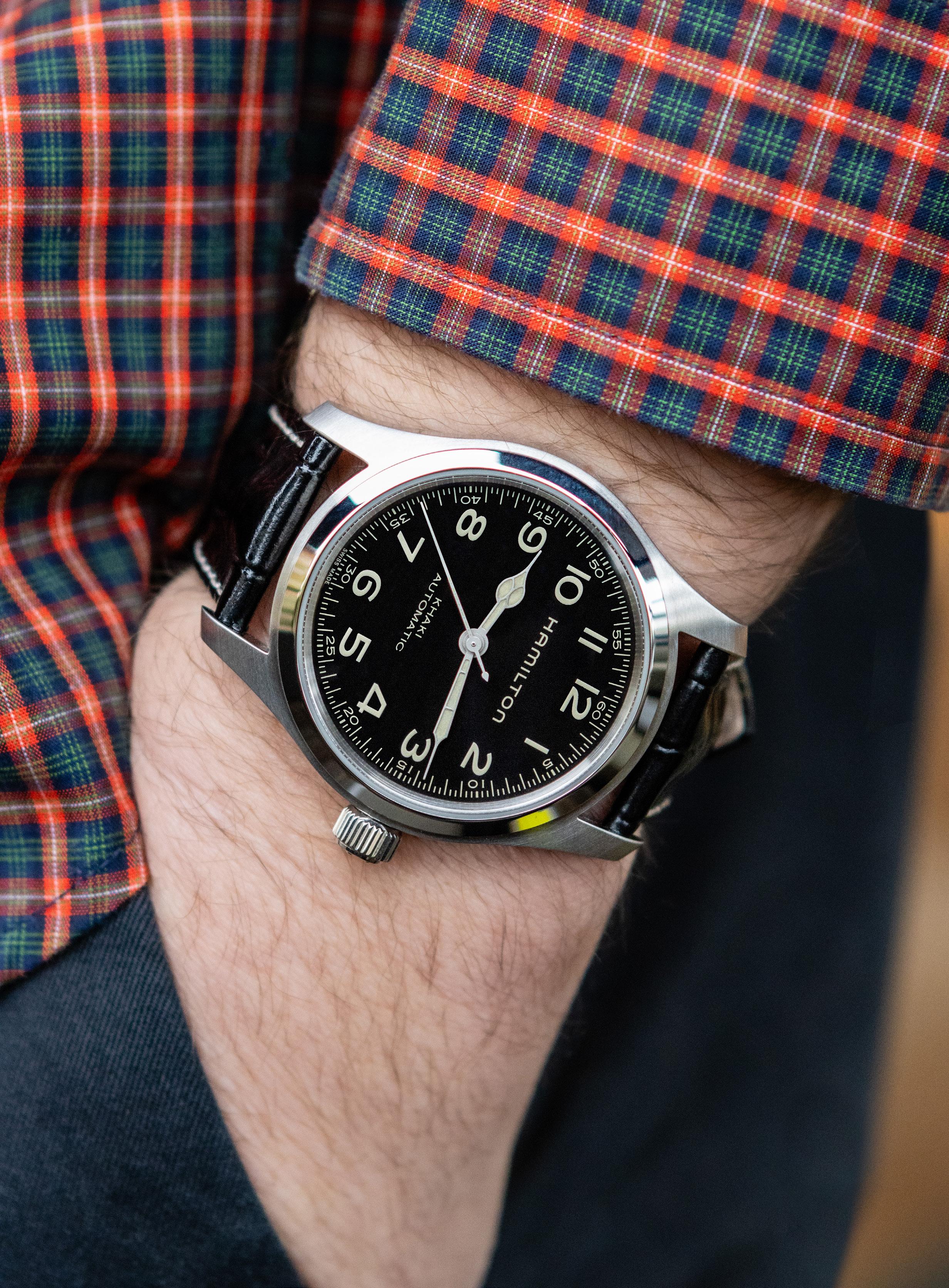
The written word. A photograph. Video. All these things allow humans to communicate across time. But alas, time has its limits. Hamilton, however, does not. They’ve created a timepiece that transcends not just time but our plane of existence itself with the Murph.
The Murph was named after and made specifically for Jessica Chastain’s character in Christopher Nolan’s sci-fi epic, Interstellar (2014). In the film, Matthew McConaughey’s character, Cooper, syncs his Hamilton watch –the Khaki Aviation Pilot Day Date, ref. H64615135 – with Murph’s so they can stay connected as he travels through a blackhole. From the 5th dimension, Cooper sends Murph quantum data collected from within a black hole using Morse code by manipulating the second hand of her watch, unlocking an equation that Murph uses to save humanity from extinction.
Five years after the endlessly rewatchable Interstellar reignited a new generation’s imagination of space travel, the iconic image of the Murph held strong in the minds of watch enthusiasts. The demand to own the Murph only grew, and Hamilton delivered.
The initial 42mm and recently released 38 mm Murph, from Hamilton’s Khaki Field collection, have made the fantasy real. Going even further to serve the fans of the watch, Hamilton inscribed “Eureka” –which Murph exclaims when she solves the equation in the movie – in Morse code on the seconds hand.
Its other-worldly design not only draws
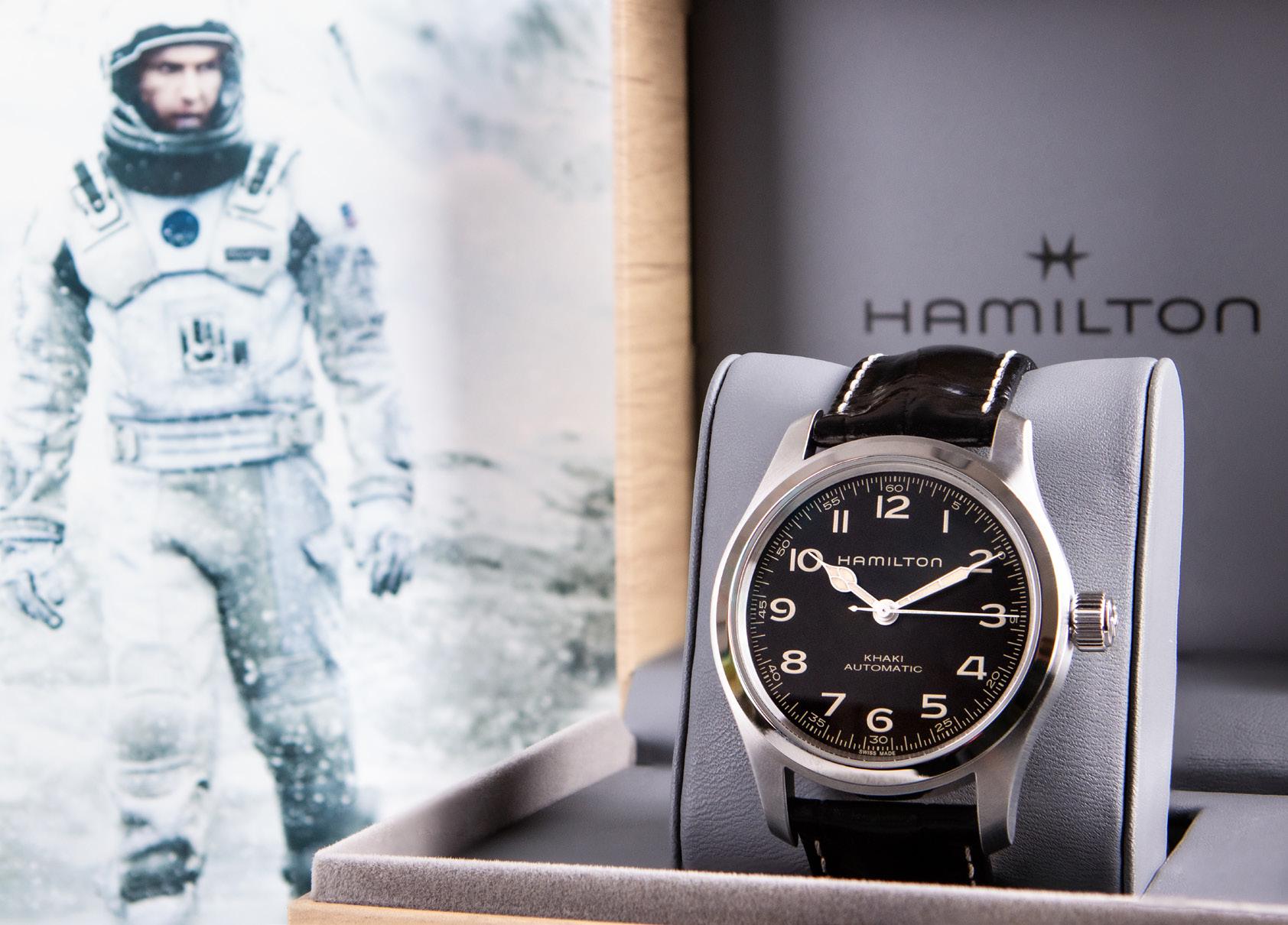
one’s gaze whether on the silver screen or not – it’s also among the finest watches on the market. Made with Hamilton’s Swiss watchmaking prowess, and just one piece of the company’s Khaki line of rugged, military-style watches, the Murph has an automatic movement, has 80 hours of reserve power and is water resistant up to 100 meters.
The stainless steel case has an open back, has a black dial protected by a sapphire crystal, and is secured with a calf leather strap.
Both the 42mm and 38mm come in under $1,000 – the 42mm at $995 and the 38mm at $895 – giving them a better value than other watches in their class.
Interstellar isn’t the first time Hamilton’s craftsmanship has played a starring role in
a major Hollywood hit, and the Murph isn’t even the only Hamilton watch in the movie. Hamilton has lended style and class to Captain America, Indiana Jones, and the stars of the Men in Black series, along with characters in more than 500 movies. That’s an achievement that’s only possible with a proven track record of pinpoint accuracy in capturing artistic vision, matching personality with aesthetics in a way that deepens the fictional world.
The Murph is both fantasy and reality. To own one is both possess a piece of cinematic history – Interstellar is an unparalleled achievement in sci-fi storytelling and special effects that will be a benchmark for generations of filmmakers and cinephiles – and a reliable, stylish tool to help you navigate life in this dimension. |
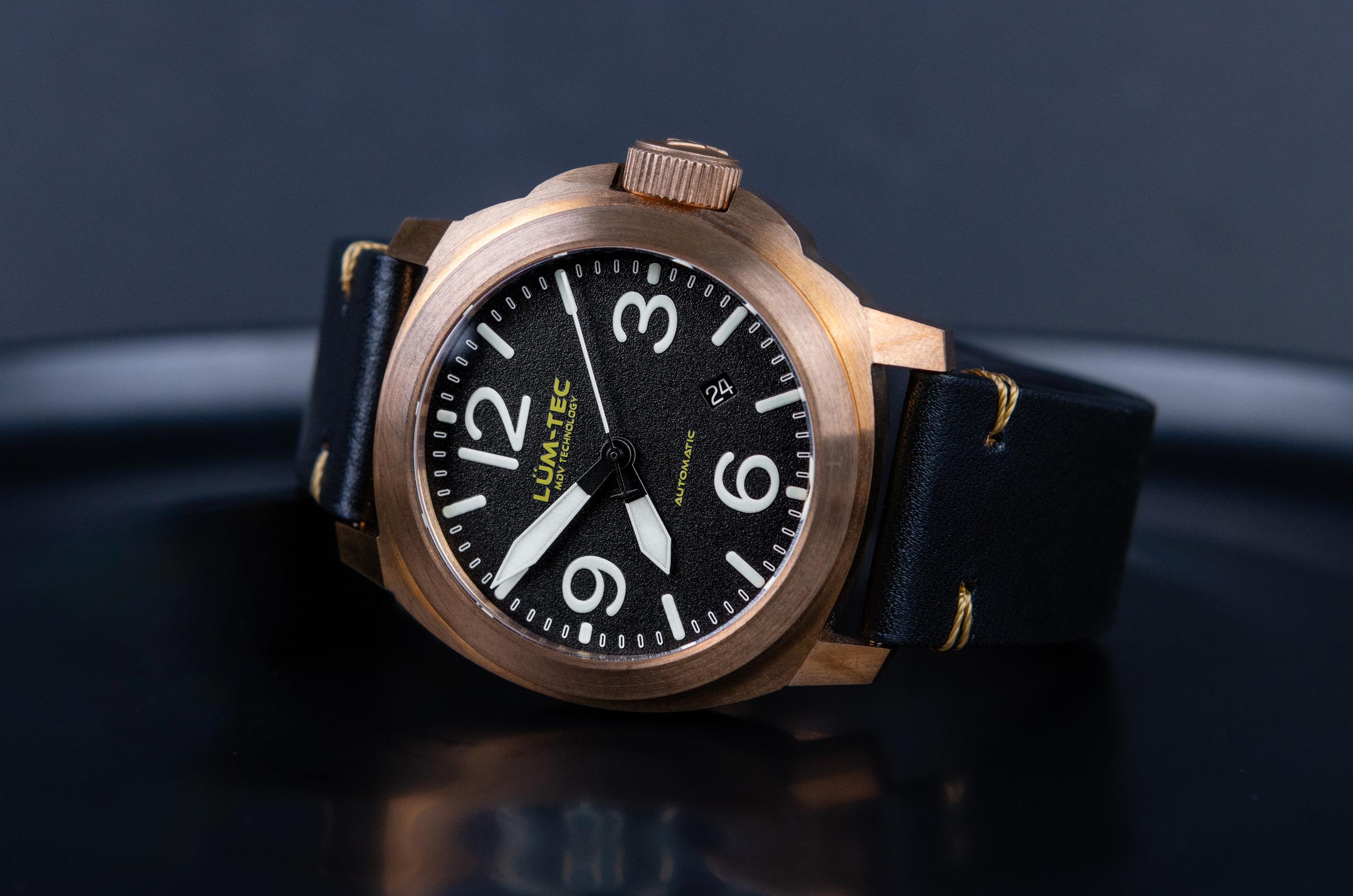
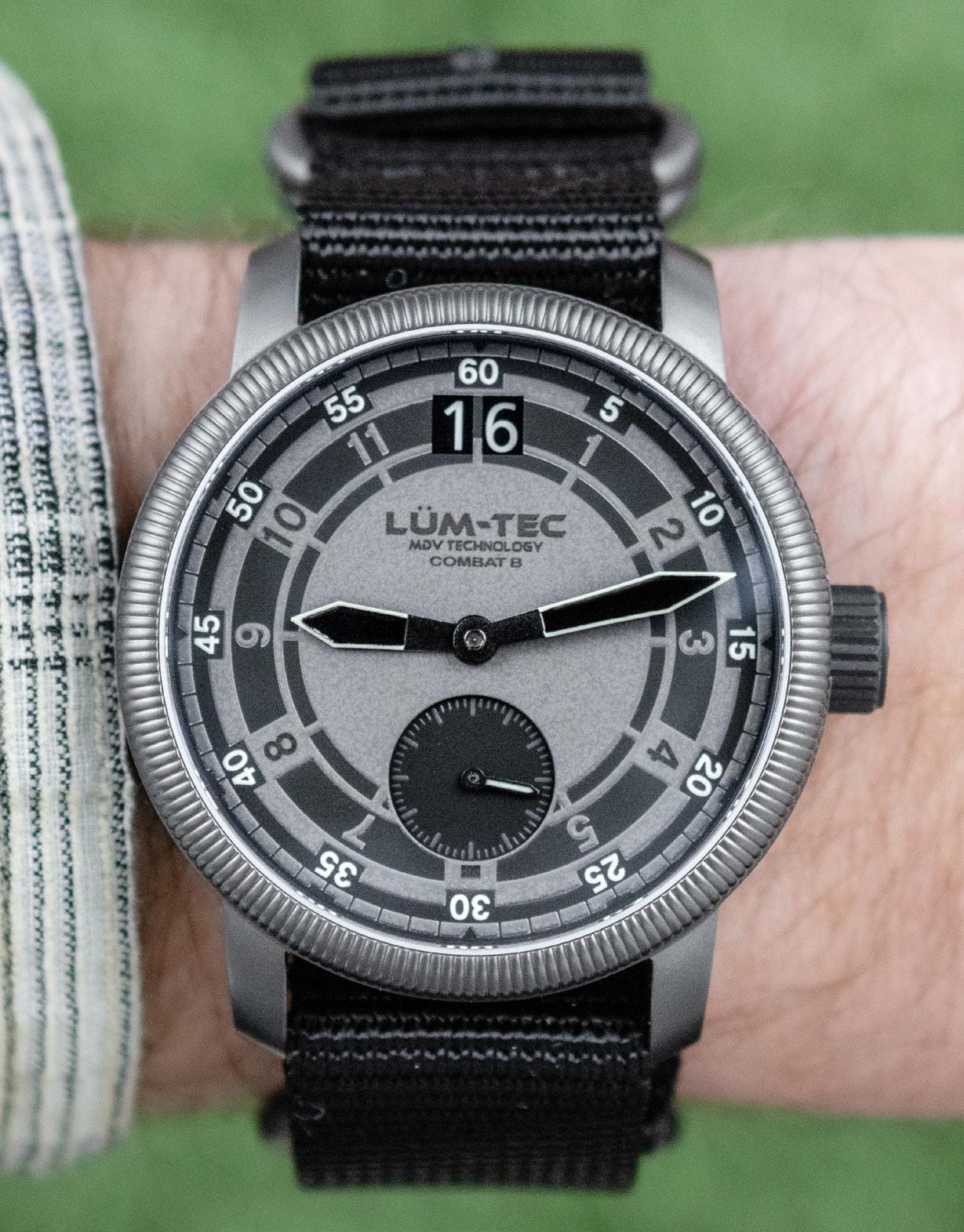

American watches don’t get spoken about with the same grandiosity that those from other parts of the globe do – no need mentioning them again. For as much as Americans drive the trends and profits for these sage craftsmen, it’s about time for someone on the other side of the Atlantic to emerge with a bold, fresh vision in watchmaking.
Enter LÜM-TEC. Founded by its president, Chris Weigand in 2008, this family-run company has established itself as a force to be reckoned with on wrists around the world. Their bold, rugged designs capture a particularly American sense of ingenuity, throwing out the rule book to create their own reference point for what watches can be.
LÜM-TEC, based in Ohio, incorporates pieces of the best watch components from around the world, from Switzerland, France, Japan, Hong Kong, Germany as well as from craftsmen in the U.S. of A. LÜM-TEC is the showcase for its parent company, Weigand Custom Watches, which constructs custom OEM and ODM timepieces to their clients’ specifications, currently serving more than 100 watch companies both large and small.
While the form of LÜM-TEC watches alone is enough to separate them from the crowd, what keeps customers coming back is their utility, comfort and ability to withstand punishment. LÜM-TEC proves that combat-ready, tactical watches don’t have to sacrifice style.

Every component is optimized for longevity. They’re made with stainless steel cases, water resistant up to 200 meters, are shock-resistant, and their solar powered models can last a full day on just one minute of sunlight.
When the lights are out, LÜM-TEC literally separates from the rest with their exclusive innovation in luminescence. Their MDV (Maximum Darkness Visibility) Technology involves the application of eight layers of ultra bright Super-Luminova photoluminescent material that keeps the time legible at a depth of 600 meters.
LÜM-TEC has 24 watch models currently available, with 11 new designs slated for release in summer 2024. Their average
price is just over $600, a figure inflated by their Super Combat B2 model which comes in at $1,895. This makes them an affordable alternative to the likes of Luminox or Marathon.
As the company’s president, Chris Weigand makes himself available to customers to answer their questions or help them in any way he can – a personal touch that exemplifies his pride in their products and his commitment to customer satisfaction.
LÜM-TEC watches aren’t the result of a closed, sanitized process followed by faceless, pretentious, untouchable “artisans.” They’re hand-made and handassembled by the same hands that you could just as easily shake after striking up a conversation at your local diner. |




A unique watch shop in Raleigh, N.C. featuring a bourbon bar, men’s jewelry, unique gifts, & timepieces.